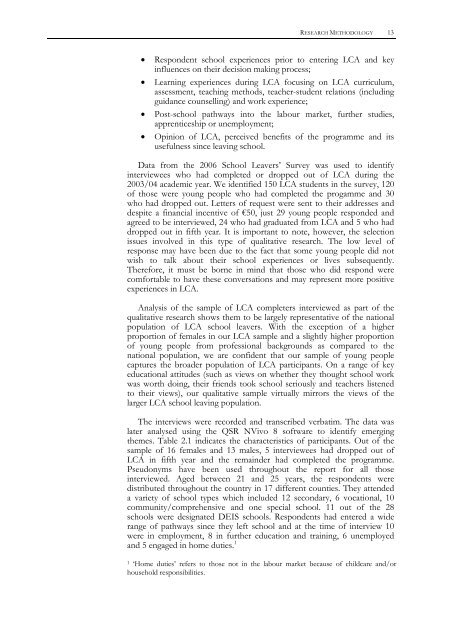Student Experiences of the Leaving Certificate Applied Programme
Student Experiences of the Leaving Certificate Applied Programme
Student Experiences of the Leaving Certificate Applied Programme
You also want an ePaper? Increase the reach of your titles
YUMPU automatically turns print PDFs into web optimized ePapers that Google loves.
RESEARCH METHODOLOGY 13• Respondent school experiences prior to entering LCA and keyinfluences on <strong>the</strong>ir decision making process;• Learning experiences during LCA focusing on LCA curriculum,assessment, teaching methods, teacher-student relations (includingguidance counselling) and work experience;• Post-school pathways into <strong>the</strong> labour market, fur<strong>the</strong>r studies,apprenticeship or unemployment;• Opinion <strong>of</strong> LCA, perceived benefits <strong>of</strong> <strong>the</strong> programme and itsusefulness since leaving school.Data from <strong>the</strong> 2006 School Leavers’ Survey was used to identifyinterviewees who had completed or dropped out <strong>of</strong> LCA during <strong>the</strong>2003/04 academic year. We identified 150 LCA students in <strong>the</strong> survey, 120<strong>of</strong> those were young people who had completed <strong>the</strong> progamme and 30who had dropped out. Letters <strong>of</strong> request were sent to <strong>the</strong>ir addresses anddespite a financial incentive <strong>of</strong> €50, just 29 young people responded andagreed to be interviewed, 24 who had graduated from LCA and 5 who haddropped out in fifth year. It is important to note, however, <strong>the</strong> selectionissues involved in this type <strong>of</strong> qualitative research. The low level <strong>of</strong>response may have been due to <strong>the</strong> fact that some young people did notwish to talk about <strong>the</strong>ir school experiences or lives subsequently.Therefore, it must be borne in mind that those who did respond werecomfortable to have <strong>the</strong>se conversations and may represent more positiveexperiences in LCA.Analysis <strong>of</strong> <strong>the</strong> sample <strong>of</strong> LCA completers interviewed as part <strong>of</strong> <strong>the</strong>qualitative research shows <strong>the</strong>m to be largely representative <strong>of</strong> <strong>the</strong> nationalpopulation <strong>of</strong> LCA school leavers. With <strong>the</strong> exception <strong>of</strong> a higherproportion <strong>of</strong> females in our LCA sample and a slightly higher proportion<strong>of</strong> young people from pr<strong>of</strong>essional backgrounds as compared to <strong>the</strong>national population, we are confident that our sample <strong>of</strong> young peoplecaptures <strong>the</strong> broader population <strong>of</strong> LCA participants. On a range <strong>of</strong> keyeducational attitudes (such as views on whe<strong>the</strong>r <strong>the</strong>y thought school workwas worth doing, <strong>the</strong>ir friends took school seriously and teachers listenedto <strong>the</strong>ir views), our qualitative sample virtually mirrors <strong>the</strong> views <strong>of</strong> <strong>the</strong>larger LCA school leaving population.The interviews were recorded and transcribed verbatim. The data waslater analysed using <strong>the</strong> QSR NVivo 8 s<strong>of</strong>tware to identify emerging<strong>the</strong>mes. Table 2.1 indicates <strong>the</strong> characteristics <strong>of</strong> participants. Out <strong>of</strong> <strong>the</strong>sample <strong>of</strong> 16 females and 13 males, 5 interviewees had dropped out <strong>of</strong>LCA in fifth year and <strong>the</strong> remainder had completed <strong>the</strong> programme.Pseudonyms have been used throughout <strong>the</strong> report for all thoseinterviewed. Aged between 21 and 25 years, <strong>the</strong> respondents weredistributed throughout <strong>the</strong> country in 17 different counties. They attendeda variety <strong>of</strong> school types which included 12 secondary, 6 vocational, 10community/comprehensive and one special school. 11 out <strong>of</strong> <strong>the</strong> 28schools were designated DEIS schools. Respondents had entered a widerange <strong>of</strong> pathways since <strong>the</strong>y left school and at <strong>the</strong> time <strong>of</strong> interview 10were in employment, 8 in fur<strong>the</strong>r education and training, 6 unemployedand 5 engaged in home duties. 11 ‘Home duties’ refers to those not in <strong>the</strong> labour market because <strong>of</strong> childcare and/orhousehold responsibilities.

















